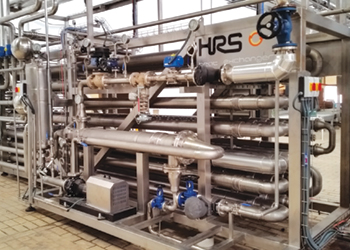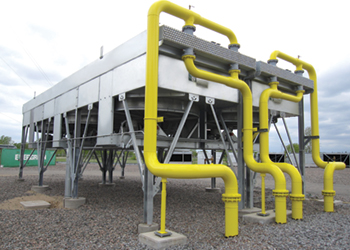
 A typical HRS heat exchanger
A typical HRS heat exchanger
With about 40 years of experience designing and installing heat exchangers, HRS Heat Exchangers engineers and sales staff have encountered a wide range of issues on sites
Not keeping to recommended cleaning or service intervals will quickly reduce heat exchanger performance.
With about 40 years of experience designing and installing heat exchangers – whether as part of a brand new production line or as an upgrade or replacement to an existing unit – HRS Heat Exchangers engineers and sales staff have encountered a wide range of issues on sites.
Here are 10 of the most common mistakes that can occur as a result of poorly-specified or badly-installed heat exchanger systems, and, most importantly, how you can avoid them on your next project, writes Matt Hale, International Sales and Marketing Director, HRS Heat Exchangers. Located in Phoenix and Atlanta, HRS Heat Exchangers is part of the HRS Group, which operates at the forefront of thermal technology, offering heat transfer solutions worldwide across a diverse range of industries.
EXCESSIVE FOULING
The consequences of excessive fouling within a heat exchanger can range from minor inconvenience (a greater need for regular cleaning) to catastrophic (material failure of industrial heat exchangers caused by chemical fouling and material corrosion). Excessive fouling during operation can also reduce operational efficiency and increase energy consumption.
There can be many reasons behind this. Food products containing high levels of protein can be a cause of heat exchanger fouling, as can those containing certain starches or enzymes. In waste management situations, fouling from limescale, struvite, and vivanite can be especially problematic.
The best solution is to avoid excessive fouling in the first place by choosing the right type of heat exchanger for your application. Scraped surface or corrugated tube designs reduce fouling by increasing turbulence in the tube. Maintaining the correct temperature range will also help to reduce the problem, and where particular problems are anticipated, additional chemical treatment, such as acid dosing, may be required.
WRONG MATERIAL CHOICE
Bear in mind that cheaper isn’t necessarily best. The problems caused by specifying the wrong type of material for your heat exchanger range from the need for additional cleaning, through to catastrophic failure of the unit.
For example, although carbon steel is cheaper than stainless steel and easier to work with – making it a popular choice for those on a budget – it is also more vulnerable to corrosion and chemical reaction. Thicker tube walls are required compared to stainless steel, which increases the weight of comparable heat exchanger units and may add to associated costs, such as concrete bases and mounting brackets. Furthermore, carbon steel is brittle and while it may have a higher thermal conductivity than other materials, this can rapidly be degraded by the build-up of corrosion or fouling layers, reducing its service life.
If possible, opt for a material that is both hygienic and hard-wearing, but that also provides good thermal characteristics in the design of heat exchanger that you are considering, such as stainless steel.
INCORRECT PRESSURE DROP
Pressure problems usually occur when the pressure drop in the heat exchanger is higher than the design parameters. In the worst-case scenario this can lead to leaks, contamination, or heat exchanger failure.
One reason for an increase in the pressure drop might be a change in raw material specification (for example, switching ingredient suppliers). To counteract this, you should always request full details about any new products from your suppliers and, if necessary, ask your heat exchanger supplier to test them before use. This will ensure that any new heat exchangers are correctly specified and will also help to prevent problems when switching products or ingredients.
POOR LOCATION
We have encountered heat exchangers crammed into corners, obstructed by pipework or other equipment, or fed by excessively long or complex pipework. While none of these issues will necessarily affect the performance or working life of the heat exchanger itself, if it is inconvenient to clean and service, then such routine tasks may get overlooked or extended beyond the recommended intervals, which can lead to problems.
If you are tight on space, ensure you specify a heat exchanger suitable for a small footprint. For example, corrugated tube designs are more efficient and require less space than a smooth-tube unit with the same capacity. This means that they can often be housed in smaller spaces or novel locations, such as a specially constructed mezzanine, while still allowing full access for cleaning and maintenance.
INSUFFICIENT CAPACITY
While it may be tempting to invest in a smaller unit to save money, this can prove to be a false economy. Specifying a heat exchanger that is not large enough to cope with the maximum volume or processing capacity can result in extended running hours or, in a worst-case scenario, having to turn business away.
One option may be to choose a modular solution, so that additional units can be added if extra capacity is required. Although allowing for the additional space and infrastructure may incur some cost, this is likely to be less than a much larger over-specified unit and will save money in the long term when expansion is required.
PRODUCT DAMAGE
Inappropriate product handling can easily affect key quality parameters, such as taste, appearance, or viscosity. Such issues can occur from thermal or physical treatment, or both. Common examples include rough handling of cream causing curdling; pizza sauce losing its viscosity so that it falls off the pizza; fats and spreads becoming demulsified; and fruit juices losing their fresh taste when pasteurised.
All of these effects, and more, could have been prevented by using the right heat exchanger in the first place. For example, not only are scraped-surface heat exchangers good at preventing fouling with viscous products, they can also handle sauces more gently than a turbulent tubular design, retaining the all-important product characteristics.
LACK OF BACKUP OR SAFETY SYSTEMS
If a pump fails elsewhere in the system, material may remain too long in the heat exchanger, becoming too hot or too cold. This can result not only in product damage but can also have additional effects on the equipment.
A well-designed heat exchanger should therefore include fail-safes to prevent damage from occurring in the event of a system failure elsewhere in the production line – for example, heating coils or a diversion system to prevent chilled products from freezing in the event of pump failure. It is also important to make sure that heat exchanger equipment is included within any monitoring and alarm systems.
INSUFFICIENT CLEANING OR MAINTENANCE
Heat exchangers that are designed to be easy to service are more likely receive the prescribed levels of maintenance. Being able to remove and inspect individual components or tubes separately and easily is the key starting point. The way in which tube plates and covers are attached is just one of many small details that can have a big effect, as can the siting of drain plugs and inspection covers.
Shortcuts in maintenance can not only affect heat exchanger performance, they can also affect the safety of food and pharmaceutical products. For example, by allowing contamination to occur through leakage. In the worst case, insufficient maintenance or inspection could lead to a failure to spot cracks or corrosion, resulting in major issues that could have been prevented.
Any good heat exchanger design should therefore make routine checking and cleaning as quick and hassle-free as possible.
POOR ENERGY EFFICIENCY
The potential for heat regeneration or product-to-product heat transfer should not be overlooked when designing your heat exchanger system, as in most cases, there will be some ‘heat’ (or cooling effect) left over in the service fluid after it has passed through the heat exchanger.
Using a design that reuses (or ‘regenerates’) this heat will reduce overall energy and running costs. For example, a pasteurisation and cooling system could use the heat removed from the product during the cooling phase to supplement the heat input used for pasteurisation. Where two low-to-medium-viscosity products need heating and cooling, it may even be possible to use a product-to-product heat exchanger, removing the additional costs and complications associated with a service fluid system.
INCORRECT DESIGN PARAMETERS
If the information provided to the designers of the heat exchanger is wrong or incomplete, then the installed unit will not perform optimally for the product and service fluid in question. While intentionally supplying misleading information is extremely rare (not to mention counter-productive), seemingly inconsequential information can sometimes be overlooked.
It may appear as if the heat exchanger designers and engineers require an unnecessary amount of information, but this is only because they have the experience to know what variables will affect the performance and longevity of such an important asset – so trust them and provide as much information as you can.
Any uncertainty should be flagged up immediately; rather than guessing, it is much better to measure the required parameters, even if this involves sending product off for third party analysis. Failure to obtain the correct information will result in a heat exchanger that, at best, is inefficient and, at worst, inoperable.
In some cases, a heat exchanger is used for something different to its original design. For example, a product recipe may be changed, a new product may be introduced, or the characteristics of a waste stream are altered because of different processes elsewhere in the production line. Whenever any changes are made, the heat exchanger supplier should be consulted as simple adjustments or modifications will often help to maintain optimum heat exchanger performance.
This is by no means an exhaustive list, and the severity of almost all the issues listed above can range from mild inconvenience or extra costs, through to severe and catastrophic equipment failure. Safety must always be the prime concern and any equipment that is potentially unsafe should not be used until it has been checked and certified by a competent authority.











































































